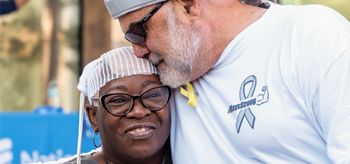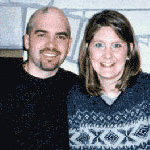Finding Peace and Empowerment
Scott
Unbelievable. That’s the word that kept coming to mind the first couple of times I went to my oncologist. Unbelievable. I distinctly remember exiting the elevator, turning to my left, and seeing the words “Neurological Oncology” on the sign. It’s somewhat disheartening, to say the least, when the sign you are looking for has “Oncology” on it. But that’s where I was headed. Unbelievable.
I actually don’t remember much at all about the first meeting with my oncologist. I’m glad I had my wife, Cheryl, with me. She remembers more. One thing I do remember is that my doctor asked me if I had been told my condition. I told her I had. Her response was, “These can be difficult tumors.” Now that I know a little more about glioblastoma multiforme, I think she was being gracious in her use of adjectives. I also remember seeing my post-surgical MRI, which showed a big hole in my brain where the tumor had been. Unbelievable. The last thing I remember of that visit was the sense of urgency I felt as my doctor left the exam room and headed for a phone to get my radiation treatments scheduled. I’m a cancer patient. Unbelievable.
From what I gather, my experience was fairly typical as far as operable, malignant brain tumors go: the usual assault of surgery, external beam radiation, and a Gamma Knife procedure. The reason I’m writing this article is that I want others out there to know that in the face of a malignant brain tumor, or any other life-threatening disease, there are resources and strategies that can help you find “the calm at the middle of the storm.” You don’t have to look further than your own circle of family, friends, and medical and mental health professionals that you choose to surround you. You also have tremendous inner resources that can be harnessed for your own benefit. I want to share how I gathered people around me, and how I gathered my inner resources together, so I wouldn’t have to bear the burden of this disease all on my own. For those who know, it can be a terrible burden.
Before I go into how I gathered my resources together, I would like to describe how I approached the disease in general. You hear a lot about people who have “battled” or “fought” cancer. From the outset I, too, considered it somewhat of a battle. I have, however, tried to incorporate love into the fight. For example, as I was lying in the emergency room after they discovered the tumor, I somehow was given the strength to repeat over and over and over to myself, “I send Love to my brain.” In a sense, I guess, I was forgiving the disease for invading my body, at the same time forgiving my body from allowing it to enter.
This kind of mental visualization, along with other “complementary” methods, has been instrumental in my finding peace and empowerment in the face of a terrifying illness. I believe “complementary” is a more appropriate word than “alternative,” because, for me at least, they serve to complement and enhance (rather than replace) the traditional treatments I received. I am thoroughly convinced they help my body, mind, and spirit tolerate and withstand the punishing assault of the traditional treatments better than I would have without them. Other complementary methods I have found helpful are meditation, prayer, relaxation, exercise, counseling, and nutrition / vitamin therapy. The way I saw it, I couldn’t afford to neglect either the traditional or the complementary. As I tearfully told my oncologist, “If I die, I want to know I did everything possible.”
An essential part of my strategy in the beginning was to surround myself with an outer healing team. My team consisted of my neurosurgeons, neurologist, oncologist, radiation oncologist, primary care physician and physician’s assistant, therapist, and family and friends. I considered all to be capable of carrying part of the burden of the illness for me. My neurosurgeon said to me before the craniotomy, “Let me do the worrying for you.” That statement not only engendered trust and confidence, but it also made me feel like I was not just another patient. He considered me to be a fellow human being and was acknowledging not only my physical symptoms, but my emotional as well. I trusted him implicitly.
The glue that has bound my outer team together, and has allowed the unburdening to take place, is a combination of communication, trust, and honesty. Open lines of communication have been essential, especially with my medical team. For example, in the beginning there were certain pieces of information I did not want to hear, such as survival rates. I made it a point to make sure my doctors knew exactly what I wanted to know and did not want to know.
Open lines of communication have been essential with other members of my outer healing team. For example, in the beginning I called my family together to make sure all our questions were addressed and all our fears brought out into the open. I let my family know that I wanted them to be open and honest with their feelings.
The bottom line is that I didn’t want to waste time worrying about whether one of my doctors was going to give me some statistic I didn’t want to hear, or about whether my family was hiding their feelings from me. I trusted all of them to do their job. And as I trusted, I was unburdened. And as I was unburdened, I found I conserved time and energy, two important allies in dealing with cancer.
I, as well, was a part of the outer healing team. My therapist called me the “general.” I guess she called me that because I delegated everyone a task. I suppose that was part of how I helped myself feel empowered. The task I gave myself was to focus on creating an inner healing team. That’s been my truest, yet most difficult, work. But it’s been the most crucial.
I remember being so fearful one night in bed that the muscles in my neck felt like rods of steel and my chest was so tight I thought I was going to have a heart attack. Those physical symptoms were a direct result of the mental stress of knowing I had cancer. Since that stress was in my own mind, my outer healing team could not relieve me of it. I had to do the work myself. So I created a team of inner characters to recondition my mind and play out my version of the story of my illness.
Developing an inner healing team is very similar to developing an outer one. There are, however, some differences. An outer healing team is formed of physical people, whereas an inner healing team is formed of mental images, which are specifically chosen to bring about a certain state of mind. These images can be anything you choose, ranging from people and animals, to geographic locations, or even favorite colors or music. One of the keys in choosing your own cast of inner characters is that immediately upon thinking go each one they should bring about not only a mental picture of that character or thing performing some task, but also a sense of trust, peace, and well-being that someone is acting on your behalf.
It took me some time to put my inner healing team together. I used a variety of characters including sports heroes and movie personalities. I also made up specific images of what these characters where doing to the cancer cells. I even developed an image of the cancer cells themselves and how they were behaving and reacting to my inner team. (Cancer cells aren’t very intimidating if you visualize them in their underwear! Humor definitely has a place in healing.)
I will share a few of my inner team members with you. First, I used one of my sports heroes, the baseball player Mark McGwire. His task was to counteract any negative thoughts I would have. I imagined myself as a pitcher and a basket full of baseballs (representing my negative thoughts). I would pitch them to Mark and he would blast them out of the park (out of my mind). I also used a picture of Muhammad Ali to inspire a sense of invincibility. I taped it right below the bathroom mirror so I could see it many times a day, until the image became ingrained in my mind and the feeling of indestructibility was emblazoned in my heart.
Visualization does not have to be limited to the sense of vision. Another technique I used was to visualize a broken strand of DNA being put back together perfectly. As I did so I would also “hear” the broken pieces coming together like pieces of steel to give it a sense of strength. I also brought my favorite CDs into the treatment room with me. The technicians would play them for me as I underwent radiation. I chose music that would make me feel energized, calm, peaceful, or whatever I felt was best to get the inner healing team charged up. And they played it loud. So loud, in fact, that one of the technicians said, “They’re going to think we’re having a party in here!” Hey, whatever works.
I guess the bottom line with visualization is to not limit yourself. I found many times the first image or thought that came to mind tended to be one that I would use. They tended to be the most powerful. Let your imagination run wild. Choose a cast of inner characters and images that you will want to think about every day and let them carry part of the burden of the illness for you.
This, in a nutshell, has been my strategy for finding “the calm at the middle of the storm.” It’s been unburdening myself. It’s been about love, teamwork, communication, trust, honesty, patience, and perseverance. It’s been about focusing effort on the inside as well as the outside. It hasn’t been easy. There have been many ups and downs, but my strategy has helped me stay focused even in the down times.
Perhaps some day we will know more about the mind-body-spirit connection and whether techniques such as visualization can ultimately affect a physical outcome. I continue to have faith that there is at least some positive effect. And if that effect isn’t influential enough to overcome an illness, at the very least it will have had a profound influence on the mind and spirit. There’s no reason why cancer, or any other illness, has to invade those as well.
I would like to dedicate this article to all brain tumor and cancer patients out there, and to those who are caring for them. You are all brave souls. God bless.
In 1999 Scott was diagnosed with a GBM, and wrote this story in 2000. He and his wife Cheryl live in San Jose, California. You can visit Scott’s website at: www.scottnorrisartstudio.com.



